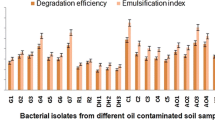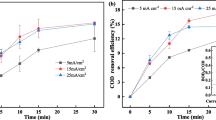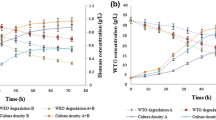Abstract
Using carbon tetrachloride (CCl4) as extraction agent, the activated sludge from Tianjin Jizhuangzi Sewage Treatment Plant as inoculum, the test study on biodegradability of lubricants was carried out. The test flasks containing the mineral medium, the test oil and the inoculum were placed in incubation together with flasks containing poisoned blanks for periods of 0 and 21 days, respectively. Flasks containing the reference materials in place of the test oil were run in parallel. At the end of the incubation period, the contents of the flasks were subjected to sonic vibration, and were acidified and extracted by using CCl4. The extracts were then analysed by infra-red (IR) spectrometer to measure the maximum absorption of the C-H stretch of CH2-CH3 band at wavelength of 2 930 cm−1. The absorption values were used to calculate the residual oil contents of the poisoned and test flasks. Consequently the biodegradability of the test oil was calculated. The test results indicate that the differences in the biodegradability of test materials in different tests are within 5.5%, and consistent with the data described in Coordinating European Council (CEC) L-33-A-93. The biodegradability of lubricants can be evaluated by this method effectively.
Similar content being viewed by others
References
Battersby N S, Morgan P. A note on the use of the CEC L-33-A-93 test to predict the potential biodegradation of mineral oil based lubricants in soil[J]. Chemosphere, 1997, 35(8):1773–1779.
Lee Sang-hwan, Lee Seokho, Kim Dae-yeon et al. Degradation characteristics of waste lubricants under different nutrient conditions[J]. Journal of Hazardous Materials, 2007, 143(1/2): 65–72.
Battersby N S, Pack S E, Watkinson R J. A correlation of the biodegradability of oil products in the CEC-L-33-T-82 and modified Sturm-tests[J]. Chemosphere, 1992, 24(12): 1989–2000.
Novick N J, Mehta P G, McGoldrick P B. Assessment of the biodegradability of mineral oils and synthetic ester base stocks, using CO2 ultimate biodegradability tests and CEC-L-33-T-82[C]. In: Proceedings of CEC Fourth International Symposium on the Performance Evaluation of Automotive Fuels and Lubricants. Coordinating European Council, Birmingham, UK, 1993. 5–7.
Coordinating European Council for the Development of Performance Tests for Transportation Fuels. CEC L-33-A-93 Lubricants and Other Fluids. Biodegradability of Two-Stroke Cycle Outboard Engine Oils in Water[S]. Coordinating European Council, Brussels, Belgium, 1995.
Organisation of Economic Cooperation and Development. OECD Guideline for Testing of Chemicals: Ready Biodegradability[M]. Organisation of Economic Cooperation and Development, Paris, 1992.
Yang Lihe, Xie Shiwen. Ecological assessment of green lubricating oils[J]. Lubrication Engineering, 2006 (11): 190–193(in Chinese).
Andreas Willing. Lubricants based on renewable resources: An environmentally compatible alternative to mineral oil products[J]. Chemosphere, 2001, 43(1): 89–98.
Battersby N S. The biodegradability and microbial toxicity testing of lubricants: Some recommendations[J]. Chemosphere, 2000, 41(7): 1011–1027.
Wilfried J B. Lubricants and the environment[J]. Tribology International, 1998, 31(1–3): 35–47.
Peter Reuschenbacha, Udo Paggaa, Uwe Strotmann. A critical comparison of respirometric biodegradation tests based on OECD 301 and related test methods[J]. Water Research, 2003, 37(7): 1571–1582.
Author information
Authors and Affiliations
Corresponding author
Additional information
Supported by China Petroleum & Chemical Corporation (No. 104141).
YANG Lihe, born in 1966, male, Dr, associate Prof.
Rights and permissions
About this article
Cite this article
Yang, L., Zhu, Y., Fan, G. et al. Test on evaluation method for biodegradability of lubricants. Trans. Tianjin Univ. 14, 61–65 (2008). https://doi.org/10.1007/s12209-008-0012-z
Accepted:
Published:
Issue Date:
DOI: https://doi.org/10.1007/s12209-008-0012-z




